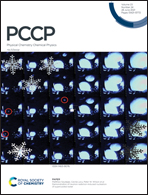Guanidine as a strong CO2 adsorbent: a DFT study on cooperative CO2 adsorption†
Abstract
Among the various carbon capture and storage (CCS) technologies, the direct air capture (DAC) of CO2 by engineered chemical reactions on suitable adsorbents has attained more attention in recent times. Guanidine (G) is one of such promising adsorbent molecules for CO2 capture. Recently Lee et al. (Phys. Chem. Chem. Phys., 2015, 17, 10925–10933) reported an interaction energy (ΔE) of −5.5 kcal mol−1 for the G⋯CO2 complex at the CCSD(T)/CBS level, which was one of the best non-covalent interactions observed for CO2 among several functional molecules. Here we show that the non-covalent G⋯CO2 complex can transform to a strongly interacting G–CO2 covalent complex under the influence of multiple molecules of G and CO2. The study, conducted at M06-2X/6-311++G** level density functional theory, shows ΔE = −5.7 kcal mol−1 for G⋯CO2 with an N⋯C distance of 2.688 Å while almost a five-fold increase in ΔE (−27.5 kcal mol−1) is observed for the (G–CO2)8 cluster wherein the N–C distance is 1.444 Å. All the (G–CO2)n clusters (n = 2–10) show a strong N–CO2 covalent interaction with the N–C distance gradually decreasing from 1.479 Å for n = 2 to 1.444 Å for n = 8 ≅ 9, 10. The N–CO2 bonding gives (G+)–(CO2−) zwitterion character for G–CO2 and the charge-separated units preferred a cyclic arrangement in (G–CO2)n clusters due to the support of three strong intermolecular O⋯HN hydrogen bonds from every CO2. The O⋯HN interaction is also enhanced with an increase in the size of the cluster up to n = 8. The high ΔE is attributed to the large cooperativity associated with the N–CO2 and O⋯HN interactions. The quantum theory of atoms in molecules (QTAIM) analysis confirms the nature and strength of such interactions, and finds that the total interaction energy is directly related to the sum of the electron density at the bond critical points of N–CO2 and O⋯HN interactions. Further, molecular electrostatic potential analysis shows that the cyclic cluster is stabilized due to the delocalization of charges accumulated on the (G+)–(CO2−) zwitterion via multiple O⋯HN interactions. The cyclic (G–CO2)n cluster formation is a highly exergonic process, which reveals the high CO2 adsorption capability of guanidine.



 Please wait while we load your content...
Please wait while we load your content...